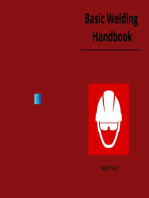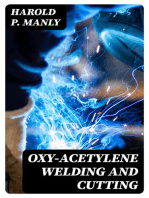CF 8 M
CF 8 M
Uploaded by
barani_g3939Copyright:
Available Formats
CF 8 M
CF 8 M
Uploaded by
barani_g3939Original Title
Copyright
Available Formats
Share this document
Did you find this document useful?
Is this content inappropriate?
Copyright:
Available Formats
CF 8 M
CF 8 M
Uploaded by
barani_g3939Copyright:
Available Formats
involving intricate shapes.
Drastic changes in section should be avoided, however, and uniform thickness
should be maintained as far as possible. This applies to the casting as cast; i.e., including finish allowance of
1/8 inch or more on surfaces to be machined. Normally used patternmakers' shrinkage allowance for this alloy
is 5/16 inch per foot.
Fabricating Considerations
Dimensional tolerances for rough castings are influenced by the quality of pattern equipment provided. In
general, overall dimensions and locations of cored holes can be held to 1/16 inch per foot.
Welding Type CF8M castings can be welded by metal-arc, inert-gas arc, and oxyacetylene gas methods.
Metal-arc is most frequently used. Oxyacetylene welding is not advisable because of possible impairment of
corrosion resistance caused by carbon pick-up. Preheating is not required, but after welding castings should
be quenched from 1950 to 2100°F (1066 to 1149°C) to restore maximum corrosion resistance. Postweld heat
treatment may be omitted provided castings will not be exposed to highly corrosive solutions. Lime coated
electrodes of similar composition (AWS E316-15) are recommended.
Welding procedures utilizing SMAW, GMAW, and GTAW techniques are described in this section.
Machining Most machining operations can be performed satisfactorily on castings of CF8M and CF12M alloys.
It is important in all cases that the tool be kept continually entering into the metal in order to avoid work-
hardening the surface. Slow feeds, deep cuts, and powerful, rigid machines are necessary for best results.
Work should be firmly mounted and supported, and tool mountings should provide maximum stiffness. Both high
speed steel and carbide tools may be used successfully. Because chips are tough and stringy, chip curler tools
are recommended.
Good lubrication and cooling are essential. The low thermal conductivity of the alloy makes it most important
to have the cutting fluid flood both the tool and the work.
Information on the procedures for specific machining operations is contained in SFSA Steel Casings Handbook,
6th Edition, Chapter 26.
Casting designations, specifications, and corresponding wrought alloy
The American Iron and Steel Institute wrought alloy designation is listed only for the convenience of those who
want to determine corresponding wrought and cast grades. Because the cast chemical composition ranges are
not the same as the wrought composition ranges, buyers should use cast alloy designations for proper
identification of castings.
Cast ASTM: A351, A743, A744 (CF8M); A451 (CPF8M); SAE 60316; MIL-S-867 (Ships) Class III.
Wrought AISI 316.
Also, practices for estimating ferrite content in cast alloys are found in ASTM A799 and A800.
Create PDF files without this message by purchasing novaPDF printer (http://www.novapdf.com)
You might also like
- Aprilia RS 50 AM6 2000 Service ManualDocument50 pagesAprilia RS 50 AM6 2000 Service ManualDaan van der MeulenNo ratings yet
- Heller Industries 1500EXL 1700EXL 1800EXL 1900EXLDocument134 pagesHeller Industries 1500EXL 1700EXL 1800EXL 1900EXLAnderson100% (1)
- Cantilever Column Systems SEAOCDocument5 pagesCantilever Column Systems SEAOCHirad Grivani100% (1)
- Astm Bolt & NutsDocument24 pagesAstm Bolt & NutsDinesh Radhakrishnan100% (4)
- Weld Like a Pro: Beginning to Advanced TechniquesFrom EverandWeld Like a Pro: Beginning to Advanced TechniquesRating: 4.5 out of 5 stars4.5/5 (6)
- Dimensions, Weights and Properties of Special and Standard Structural Steel Shapes Manufactured by Bethlehem Steel CompanyFrom EverandDimensions, Weights and Properties of Special and Standard Structural Steel Shapes Manufactured by Bethlehem Steel CompanyNo ratings yet
- Steel Casting Handbook Supplement 8 - High Alloy Data Sheets - Corrosion SeriesDocument93 pagesSteel Casting Handbook Supplement 8 - High Alloy Data Sheets - Corrosion SeriesjosemiguelzuNo ratings yet
- Cast Steel HandBookDocument93 pagesCast Steel HandBookAlexa Harper100% (1)
- SS 409M WeldingDocument12 pagesSS 409M WeldingwentropremNo ratings yet
- Soldadura de Hierro ColadoDocument10 pagesSoldadura de Hierro ColadoclnNo ratings yet
- How To Weld 254 SMO PDFDocument12 pagesHow To Weld 254 SMO PDFPrabhakar KattulaNo ratings yet
- Recom. de Soldadura XARDocument4 pagesRecom. de Soldadura XARelias667No ratings yet
- Welding Cast IronDocument10 pagesWelding Cast IronRoberto CordovaNo ratings yet
- Partie 3Document34 pagesPartie 3vincent.guilbault7894No ratings yet
- P 1554452Document4 pagesP 1554452GusmoNo ratings yet
- Guide To Structural Steel Selection - G-SpecificationsDocument56 pagesGuide To Structural Steel Selection - G-SpecificationsFelix RanillaNo ratings yet
- Weld 2507Document8 pagesWeld 2507kyaw369No ratings yet
- PB Alumec EnglishDocument12 pagesPB Alumec EnglishByron RodriguezNo ratings yet
- Fronius - MAGDocument37 pagesFronius - MAGMatej PristopecNo ratings yet
- ASTM Specifications - American Galvanizers AssociationDocument9 pagesASTM Specifications - American Galvanizers Associationwinarnob100% (1)
- Offshore Structural Plate Fabrication GuideDocument8 pagesOffshore Structural Plate Fabrication Guidedaniel_c_popa3357No ratings yet
- S6900QLDocument4 pagesS6900QLmechkashanNo ratings yet
- Welding NPTEL Lecturers - Part4Document30 pagesWelding NPTEL Lecturers - Part4Sai ChaithanyaNo ratings yet
- Standards & SpecificationsDocument12 pagesStandards & SpecificationsbashamettNo ratings yet
- Steels For Oil - Gas - ExplorationDocument16 pagesSteels For Oil - Gas - Explorationدكتور مهندس جمال الشربينىNo ratings yet
- GeneralitiesDocument11 pagesGeneralitiescriuvosNo ratings yet
- Alumec PDFDocument7 pagesAlumec PDFetamil87No ratings yet
- Fabrication Guidelines For Thin-Sheet Metallic Lining of Flue Gas Desulfurization SystemsDocument31 pagesFabrication Guidelines For Thin-Sheet Metallic Lining of Flue Gas Desulfurization SystemsSaurabh VermaNo ratings yet
- AISE No7 Ladle Hooks 1991Document9 pagesAISE No7 Ladle Hooks 1991Zhifan FuNo ratings yet
- Steel Tips Committee of California Parte 3Document237 pagesSteel Tips Committee of California Parte 3MladenMarkovicNo ratings yet
- A514 Grade S Brochure 06-25-08Document2 pagesA514 Grade S Brochure 06-25-08anjangandak2932No ratings yet
- 1993 - 10 Heavy Structural Shapes in Tension ApplicationsDocument6 pages1993 - 10 Heavy Structural Shapes in Tension ApplicationsHenry HoyosNo ratings yet
- Arcfix Arc StudDocument21 pagesArcfix Arc StudKiran Kumar KondapalliNo ratings yet
- 701 Armox Workshop RecommendationsDocument11 pages701 Armox Workshop RecommendationssudhavelNo ratings yet
- Safeguarding Against Warpage and Distortion During Hot-Dip Galvanizing of Steel AssembliesDocument2 pagesSafeguarding Against Warpage and Distortion During Hot-Dip Galvanizing of Steel Assembliesbgdaniel07100% (1)
- Gas Tungsten Arc Welding Practice:: Jobs 19-J1-J19 (Plate)Document8 pagesGas Tungsten Arc Welding Practice:: Jobs 19-J1-J19 (Plate)Willy UioNo ratings yet
- Steel Tips Committee of California Parte 3Document237 pagesSteel Tips Committee of California Parte 3RigobertoGuerraNo ratings yet
- MainTypes of Welding ProcessesDocument6 pagesMainTypes of Welding ProcessesJasmine MalolesNo ratings yet
- Equipment and Procedures For Welding AlumDocument6 pagesEquipment and Procedures For Welding AlumAmilcar AndradeNo ratings yet
- Aluminium GMAW WeldingDocument34 pagesAluminium GMAW Weldingcentaury2013No ratings yet
- Section 5. Welding and BrazingDocument27 pagesSection 5. Welding and BrazingrobinyNo ratings yet
- MC-97 For SS Welding GC-08Document20 pagesMC-97 For SS Welding GC-08kr_abhijeet72356587No ratings yet
- Algoma SteelDocument18 pagesAlgoma Steelsahzaidi544No ratings yet
- XAR 400 (WB 703) EnglischDocument3 pagesXAR 400 (WB 703) Englischgheoda8926No ratings yet
- RCF KapurthallaDocument18 pagesRCF KapurthallaSudhir Kumar50% (2)
- Aluminium Welding Pocket GuideDocument31 pagesAluminium Welding Pocket GuideRavindra S. Jivani100% (1)
- Guia Practica Eleccion AporteDocument26 pagesGuia Practica Eleccion AporteNegrito RosarinoNo ratings yet
- Nimonic 80A (TM) Super Alloy Material Property Data Sheet - Product Availability and Request A QuoteDocument5 pagesNimonic 80A (TM) Super Alloy Material Property Data Sheet - Product Availability and Request A QuotedharmatejakademNo ratings yet
- Midalloy ER70S-2Document1 pageMidalloy ER70S-2nasirfahimNo ratings yet
- Welding Parameters of XABO 890 960Document11 pagesWelding Parameters of XABO 890 960Tomáš BrtníkNo ratings yet
- Welder's Handbook (Air Products Co.)Document48 pagesWelder's Handbook (Air Products Co.)Patrick DominguezNo ratings yet
- Bolted Flanged Joint: Flanges, Studs & Gaskets. Recommended Practices for the Assembly of a Bolted Flange Joint.From EverandBolted Flanged Joint: Flanges, Studs & Gaskets. Recommended Practices for the Assembly of a Bolted Flange Joint.No ratings yet
- Spot Welding Interview Success: An Introduction to Spot WeldingFrom EverandSpot Welding Interview Success: An Introduction to Spot WeldingNo ratings yet
- Oxy-Acetylene Welding and Cutting Electric, Forge and Thermit Welding together with related methods and materials used in metal working and the oxygen process for removal of carbonFrom EverandOxy-Acetylene Welding and Cutting Electric, Forge and Thermit Welding together with related methods and materials used in metal working and the oxygen process for removal of carbonNo ratings yet
- How to prepare Welding Procedures for Oil & Gas PipelinesFrom EverandHow to prepare Welding Procedures for Oil & Gas PipelinesRating: 5 out of 5 stars5/5 (1)
- Oxy-Acetylene Welding and Cutting: Electric, Forge and Thermit Welding together with related methods and materials used in metal working and the oxygen process for removal of carbonFrom EverandOxy-Acetylene Welding and Cutting: Electric, Forge and Thermit Welding together with related methods and materials used in metal working and the oxygen process for removal of carbonNo ratings yet
- Boiler Making for Boiler Makers - A Practical Treatise on Work in the ShopFrom EverandBoiler Making for Boiler Makers - A Practical Treatise on Work in the ShopRating: 4.5 out of 5 stars4.5/5 (2)
- Barracuda Lite 19 WS RegularDocument2 pagesBarracuda Lite 19 WS RegularcarlosorizabaNo ratings yet
- Drawing JK Feb 21 ArchitectureDocument1 pageDrawing JK Feb 21 Architecturesonusk777No ratings yet
- Listado de Partes Yamaha XT 250Document91 pagesListado de Partes Yamaha XT 250hsilvabNo ratings yet
- Std. Civil Estimate r2 09.04.2013Document376 pagesStd. Civil Estimate r2 09.04.2013Amarjit KulkarniNo ratings yet
- Total Existing InventoryDocument29 pagesTotal Existing InventoryCircuit MediaNo ratings yet
- Mobile LG Monitoring View User Manual: Model PLGMVW100 Android VersionDocument48 pagesMobile LG Monitoring View User Manual: Model PLGMVW100 Android VersionJoelAndresEspinosa100% (1)
- Circuit Drawings and WiringDocument11 pagesCircuit Drawings and WiringRELOJERIANo ratings yet
- Jacques Ferrier Architecture: BeijingDocument2 pagesJacques Ferrier Architecture: BeijingHimani SharmaNo ratings yet
- Educational Resources PamphletDocument9 pagesEducational Resources PamphletBala SingamNo ratings yet
- Construction ManualDocument8 pagesConstruction ManualCkaal74No ratings yet
- Stellite 6 DS01-21708 (S R0808)Document2 pagesStellite 6 DS01-21708 (S R0808)bwv1006No ratings yet
- Difference Between HRV/ ERV and HRWDocument13 pagesDifference Between HRV/ ERV and HRWhbardhanNo ratings yet
- Boiler Chemical CleaningDocument8 pagesBoiler Chemical CleaningUmesh QurwaniNo ratings yet
- Welcome To AER817: Systems Engineering: Krishna Dev KumarDocument35 pagesWelcome To AER817: Systems Engineering: Krishna Dev KumarzaidNo ratings yet
- CBEX 350 To 800 HorsepowerDocument4 pagesCBEX 350 To 800 HorsepowersebaversaNo ratings yet
- l2cm 4 0202 RQ Tsos Rev BDocument16 pagesl2cm 4 0202 RQ Tsos Rev BidilfitriNo ratings yet
- Panchakanya Structural SteelDocument5 pagesPanchakanya Structural Steelkabira12No ratings yet
- 1 - CYLINDER and LIMIT SWITCH1 PDFDocument224 pages1 - CYLINDER and LIMIT SWITCH1 PDFThiết Bị Khí NénNo ratings yet
- Self Balancing VehicleDocument18 pagesSelf Balancing VehicleMohammedNo ratings yet
- Pid PDFDocument2 pagesPid PDFKalpesh YadavNo ratings yet
- White BookDocument3 pagesWhite BookSneha SinghNo ratings yet
- TDSSWLDocument1 pageTDSSWLBhvunesh AshaliyaNo ratings yet
- Simulation Model in Trnsys of A Solar House From Braşov, RomaniaDocument6 pagesSimulation Model in Trnsys of A Solar House From Braşov, RomaniaKirill NôstaliônNo ratings yet
- Pushover Analysis of A 19 Story Concrete Shear Wall BuildingDocument6 pagesPushover Analysis of A 19 Story Concrete Shear Wall BuildingGirish DeshmukhNo ratings yet
- EDGE 48-705 Cut and OilDocument2 pagesEDGE 48-705 Cut and Oil퀴니퀴니No ratings yet
- ISCO Major Group 8 Plant and Machine Operators and AssemblersDocument6 pagesISCO Major Group 8 Plant and Machine Operators and AssemblersГеоргий РомановNo ratings yet
- Introduction To Mechanism of MachineryDocument31 pagesIntroduction To Mechanism of Machinerydaniel hambissaNo ratings yet

























































































